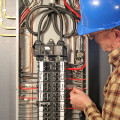The electrical wiring system within any building can look incredibly complex to anyone not well-versed in the way such systems work. It doesn’t matter if you’re in a residential area or in a commercial complex – people are dependent upon power yet know very little about it. Here are some things we thought you should know about electrical wiring in general.
Wiring Codes
Electrical codes seem like a pain, but they were created to help protect both you and your home. The codes, first established in 1891 in New York state, were put in place to ensure that the right type of wiring is used in each area. This reduces the risk of a malfunction or surge in your electrical system – one that could cause damage like electrocution or fire.
Electrical Wiring Color Codes
Electrical wiring comes in different colors for a reason. Each color tells us something specific about the wire and what it is used for. The most common colors are black, red, blue, yellow, green, and bare copper.
- Black wires indicate that a wire is hot. They usually lead to outlets and switches.
- Red wires also indicate a hot connection. They’re commonly used with appliances that require a 220 volt connection. They can often be found connected to ceiling fans or hardwired alarms like smoke detectors.
- Yellow wires and blue wires are also used for hot connections, but they are used in switches that have three or four-way connections. You’ll often see these connected to lights and fans.
- Bare copper and green wires are usually used to create safe connections during grounding.
There are a few exceptions to the wire color rules. White wires, for example, often indicate something is neutral, but they can also be used as hot wires where an additional is needed. If you use a wire for something other than it’s normal, color-coded purpose you should mark it with a piece of colored electrical tape so that it matches the normal coding.
Aluminum Wiring is Outdated
Older homes were wired with aluminum wiring but today’s codes call for copper wiring. Sadly, many homes built during the Vietnam War timeframe used aluminum because copper was being used by the military. The US Consumer Product Safety Commission estimates, on average, that a home with aluminum wiring has a 50x higher risk of developing a fire hazard issue. If that’s not a reason for an electrical upgrade, we don’t know what is.
Downed Wires are Still Energized
Do not assume that a power line is de-engergized simply because it is down or because the power in your house has gone out. They might be without energy, but they may still be holding a low level of energy. There is also no way of knowing if the power will suddenly kick back on. Your best bet is to stay away from downed wires until the pros arrive on the scene.
Rewiring a Home is a Huge Project
We’re often asked why rewiring the entire electrical system in a home is so expensive. Sadly, if you need your entire house rewired your electrical contractor will have to open up all of your walls in order to get to the old wires, replace them, and reconnect them to your outlets and switches. They they, of course, have to put your home back together again. You can save yourself some cash if you rewire your home during a remodeling project, but if you don’t have one planned and don’t have the budget for a total re-wire, you can help yourself out by making upgrades here and there so that you don’t end up subjecting yourself to a fire hazard.
Wiring can be tricky and messy, but with a talented residential or commercial contractor or electrician on your side you can’t go wrong. Never make an assumption when it comes to your household wiring. Call a professional electrician and get the right answers the first time.







Jeff thanks for the updates. Thanks for the Christmas card. Hope you and yours have a Merry Christmas and a Happy New Year.